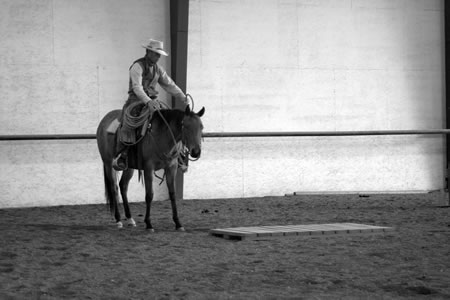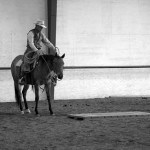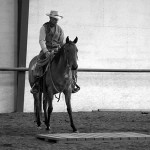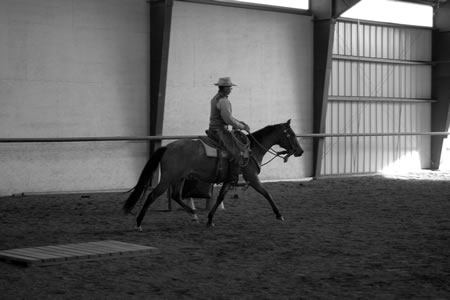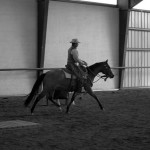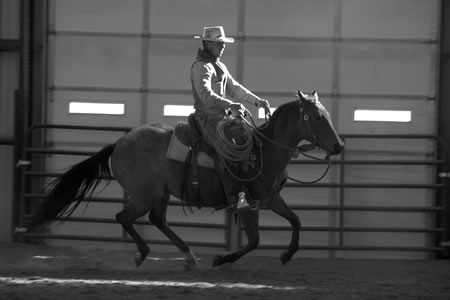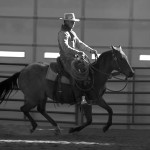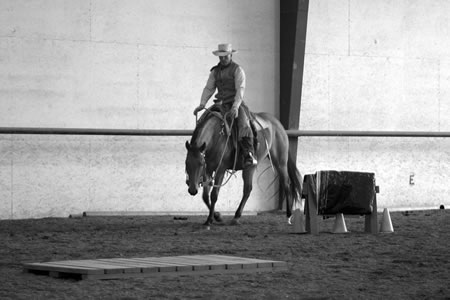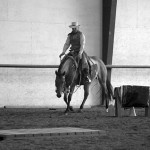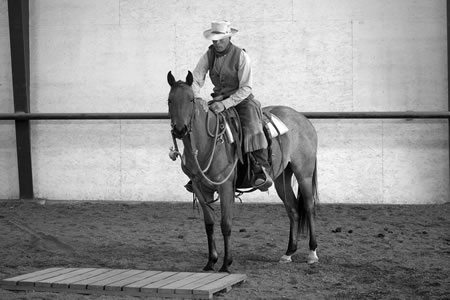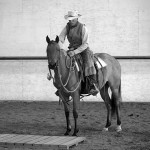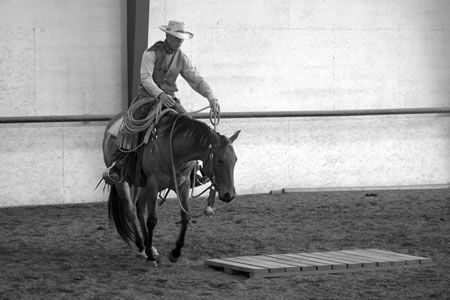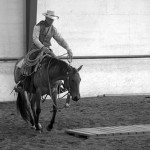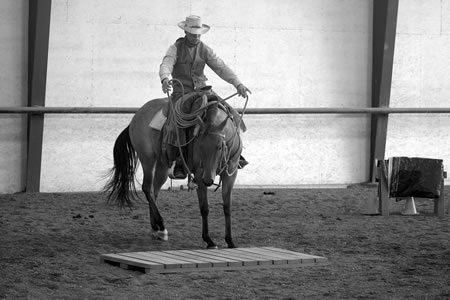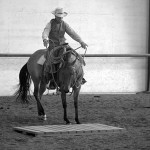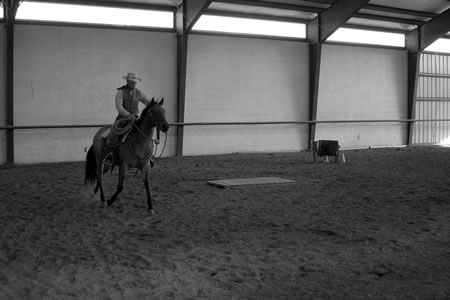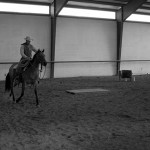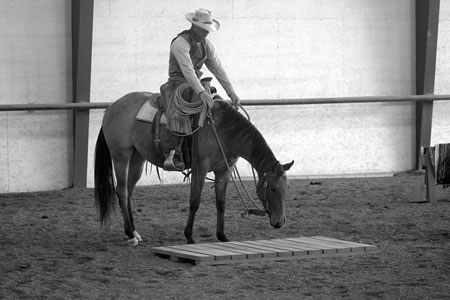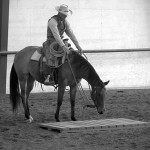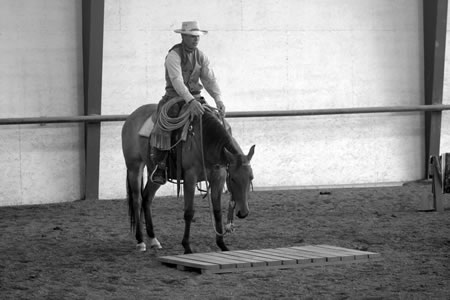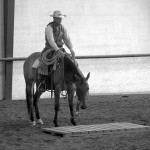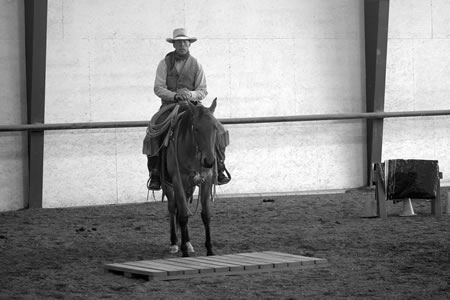With Jeff Derby
For many of us, the start of the winter season means an end to our riding season. Even if you have access to an indoor arena, it’s easy to feel limited by what you can get done in a small space or on icy ground.
Instead of focusing on the limitations the weather can create, Jeff Derby made the most of the season working on getting his horses ready using a variety of obstacles and situations. Jeff operated Strawberry Creek Ranch in Granby, Colorado, at the time this article was written where he started colts, rode his own horses, and for four months out of the year was well acquainted with winter weather.
“In the winter I do lots of work with tarps, barrels, bridges, dragging logs, flagging, etc. The idea is not just getting my horses tolerant to an object, but using an object that my horse may be unsure of or concerned about in order to build his confidence, get him more with me, and help him feel that he can put his feet anywhere I ask and he is going to be OK,” says Jeff.
“I don’t need to walk straight for a hundred yards, or head out a mile down the road, I just need to help him get ready to move out, or leave straight, and I’ve as good as done it.”

To demonstrate, Jeff rode a two-year-old filly with about 30 rides on her, and made a little project out of getting her ready to cross the bridge. In this article he will walk us through that preparation. In the next issue we will take a closer look at crossing the bridge.
“If she is bothered by the bridge, or whatever object I’m approaching, when her attention is on it, I don’t want to put any pressure on her. If her attention is on it, and I come in with my feet, she is going to associate that pressure with the bridge. When her attention is on the bridge, I’m going to give her all the time in the world to relax and find that relief. When she takes her attention off of it, that’s when I’m going to come in with my feet and suggest that she move towards it, or check it out.
“As we come up to the object, if she’s bothered, the last thing I want to try and do is hold her to the bridge. If she feels like she needs to scoot, I’m going to give her someplace to go, and say ‘Come on, let’s get out of here.’ That is my opportunity to get with her. I can direct her and scoot away from the bridge, and she gets to experience me getting with her idea. She knows that I’m considering her feelings, and she knows what that feels like now, for us to be together. And, because I’ve considered her feelings and went with her idea, she’ll feel a whole lot better about us being partners.
“I can build on that good feeling; I can start to blend my idea in. She knows that it feels good to be with me, so then she can start to get with me. Just like Ray Hunt said, ‘First you get with them, then they get with you, then you go together.’
“If she wants to leave the bridge and go away from it, I’ll help her leave. I’m letting her search at the idea of leaving the bridge. I’m letting her check where she thinks she needs to be. I’m just going to make it a little less appealing and make the easy way out to be what I had in mind.
“Then when we’re at the bridge, we’re going to rest. Pretty soon, the bridge becomes the release, and if I’m effective with that, I can get her to where she’ll go hunting the bridge, because it is the release.
“Once she is hunting the bridge we’ve got a couple things taking place. One is that if we had to cross the bridge for a trail class or to do a job, we could get it done. But for the bigger picture, she experienced that we worked at something, and the thing that I kept offering was the release. When we make it, it is going to feel comfortable to her, so that she can become more confident that what I ask her to do is going to be a good idea.
“When we leave the bridge, I want it to be my idea, and we’ll go right to work. It might not be just go, go, go. I can move her front and hindquarters, and backing up, putting some of that energy to work.
“When we come back to the bridge I’m going to let her rest and find the release. I don’t want to try and make her cross this bridge, I want her to consider it.
“Every time her head goes down (when we’re at the bridge), she is searching, and I’m going to try and get as quiet as I can. When she takes her attention away, that’s when I would come in with my legs to encourage her to search for that release again. Soon when I come in with legs, she’ll put her head down on that bridge.
“So at least she is associating the bridge with the release of pressure. I haven’t gotten that idea down to her feet yet, but I’ve got it in her mind, and that’s a start.
“As she starts to get more comfortable, one of the changes I feel is in her weight. Instead of her feeling like her weight is constantly on her hindquarters, keeping her away from the bridge as much as possible, I will feel her weight shift forward. When I come in with my legs to encourage her I will feel her attention shift on the bridge, and her weight shift forward to prepare to step across it.
“At this point I could get her across the bridge, but I think this is when it is real crucial not to try. I really want crossing the bridge to be her idea, to gain all the other big picture benefits. This is about so much more than just getting across the bridge.
“If my time were limited, at any time in this exercise when she tries or looks at the bridge I could have said ‘Thank-you, that’s enough.’
“Now that’s interesting, I just quit doing anything while I was talking and was waiting in front of the bridge, and she stepped on to the bridge with her front foot. They get the idea sometimes, and you can just get out of their way and they’ll do it. I think that is such a clear indication of when you can get what you want to be their idea, then you don’t have to do anything else.
“This would be a really good place to stop for today, or to take a little break. That might be the most difficult thing for us. I think a lot of times we want to see the final results, the proof, of their feet on the bridge as it were. But I can feel the proof underneath me in the changes that she’s made, and I know when we come back to this she’s going to be that much more sure.
“Now, if we were in a working situation we might have to cross the bridge to get the job done. But in this situation, you have to make the decision, are you riding for yourself? Or are you riding for the horse that day?”
For many of us, the start of the winter season means an end to our riding season. Even if you have access to an indoor arena, it’s easy to feel limited by what you can get done in a small space or on icy ground.
Instead of focusing on the limitations the weather can create, Jeff Derby makes the most of the season working on getting his horses ready using a variety of obstacles and situations. Jeff operates Strawberry Creek Ranch in Granby, Colorado, where he starts colts, rides his own horses, and for four months out of the year is well acquainted with winter weather.
“In the winter I do lots of work with tarps, barrels, bridges, dragging logs, flagging, etc. The idea is not just getting my horses tolerant to an object, but using an object that my horse may be unsure of or concerned about in order to build his confidence, get him more with me, and help him feel that he can put his feet anywhere I ask and he is going to be OK,” says Jeff.
“I don’t need to walk straight for a hundred yards, or head out a mile down the road, I just need to help him get ready to move out, or leave straight, and I’ve as good as done it.”
To demonstrate, Jeff rode a two-year-old filly with about 30 rides on her, and made a little project out of getting her ready to cross the bridge. In this article he will walk us through that preparation. In the next issue we will take a closer look at crossing the bridge.
“If she is bothered by the bridge, or whatever object I’m approaching, when her attention is on it, I don’t want to put any pressure on her. If her attention is on it, and I come in with my feet, she is going to associate that pressure with the bridge. When her attention is on the bridge, I’m going to give her all the time in the world to relax and find that relief. When she takes her attention off of it, that’s when I’m going to come in with my feet and suggest that she move towards it, or check it out.
“As we come up to the object, if she’s bothered, the last thing I want to try and do is hold her to the bridge. If she feels like she needs to scoot, I’m going to give her someplace to go, and say ‘Come on, let’s get out of here.’ That is my opportunity to get with her. I can direct her and scoot away from the bridge, and she gets to experience me getting with her idea. She knows that I’m considering her feelings, and she knows what that feels like now, for us to be together. And, because I’ve considered her feelings and went with her idea, she’ll feel a whole lot better about us being partners.
“I can build on that good feeling; I can start to blend my idea in. She knows that it feels good to be with me, so then she can start to get with me. Just like Ray Hunt said, ‘First you get with them, then they get with you, then you go together.’
“If she wants to leave the bridge and go away from it, I’ll help her leave. I’m letting her search at the idea of leaving the bridge. I’m letting her check where she thinks she needs to be. I’m just going to make it a little less appealing and make the easy way out to be what I had in mind.
“Then when we’re at the bridge, we’re going to rest. Pretty soon, the bridge becomes the release, and if I’m effective with that, I can get her to where she’ll go hunting the bridge, because it is the release.
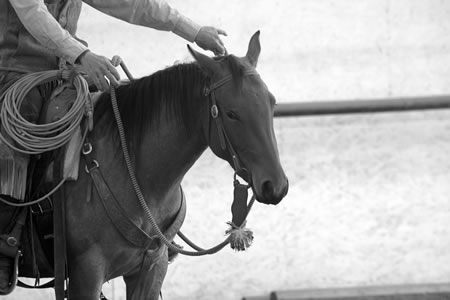
“Once she is hunting the bridge we’ve got a couple things taking place. One is that if we had to cross the bridge for a trail class or to do a job, we could get it done. But for the bigger picture, she experienced that we worked at something, and the thing that I kept offering was the release. When we make it, it is going to feel comfortable to her, so that she can become more confident that what I ask her to do is going to be a good idea.
“When we leave the bridge, I want it to be my idea, and we’ll go right to work. It might not be just go, go, go. I can move her front and hindquarters, and backing up, putting some of that energy to work.
“When we come back to the bridge I’m going to let her rest and find the release. I don’t want to try and make her cross this bridge, I want her to consider it.
“Every time her head goes down (when we’re at the bridge), she is searching, and I’m going to try and get as quiet as I can. When she takes her attention away, that’s when I would come in with my legs to encourage her to search for that release again. Soon when I come in with legs, she’ll put her head down on that bridge.
“So at least she is associating the bridge with the release of pressure. I haven’t gotten that idea down to her feet yet, but I’ve got it in her mind, and that’s a start.
“As she starts to get more comfortable, one of the changes I feel is in her weight. Instead of her feeling like her weight is constantly on her hindquarters, keeping her away from the bridge as much as possible, I will feel her weight shift forward. When I come in with my legs to encourage her I will feel her attention shift on the bridge, and her weight shift forward to prepare to step across it.
“At this point I could get her across the bridge, but I think this is when it is real crucial not to try. I really want crossing the bridge to be her idea, to gain all the other big picture benefits. This is about so much more than just getting across the bridge.
“If my time were limited, at any time in this exercise when she tries or looks at the bridge I could have said ‘Thank-you, that’s enough.’
“Now that’s interesting, I just quit doing anything while I was talking and was waiting in front of the bridge, and she stepped on to the bridge with her front foot. They get the idea sometimes, and you can just get out of their way and they’ll do it. I think that is such a clear indication of when you can get what you want to be their idea, then you don’t have to do anything else.
“This would be a really good place to stop for today, or to take a little break. That might be the most difficult thing for us. I think a lot of times we want to see the final results, the proof, of their feet on the bridge as it were. But I can feel the proof underneath me in the changes that she’s made, and I know when we come back to this she’s going to be that much more sure.
“Now, if we were in a working situation we might have to cross the bridge to get the job done. But in this situation, you have to make the decision, are you riding for yourself? Or are you riding for the horse that day?”
This article originally appeared in Eclectic Horseman Issue No.50
[ux_product_categories number=”10″ parent=”0″ columns=”4″ title=”Visit the Mercantile!” ]


